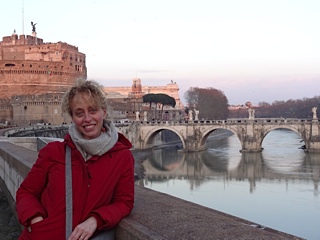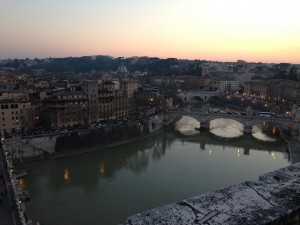Manu's Favorite things to do in Rome—the Eternal City!
March 22, 2013/in Blog/by admin
"Why I like living in Rome"...
Manu has lived all over the world and would most likely identify Siena as her “home town,” but she’s been spending a lot more time in Rome these days so we asked her about her favorite things to do in The Eternal City. Here’s what she said…
My 5 favorite things to do in Rome:
1) Walk along the Colosseum and Imperial Forum on Sunday morning when the road is closed to traffic and it’s full of pedestrians and cyclists.
2) Have an aperitivo in one of the little cafés in Via del Governo Vecchio and then go to dinner. Even in the winter you sit outside and everybody is out! It feels like summer, just with winter clothes on. ![]()
3) Watch the “Bubble Man” make giant soap bubbles at the church of Santa Maria (in the Trastevere area) to the delight of children (and adults!).
4) Watch the guys dressed up as Roman Centurions in front of the Colosseum sending text messages with their cell phones.
5) Go for a bike ride on Sunday morning, very early, while the city is still asleep and then enjoy an espresso and croissant on the terrace of a café in some little piazza (not being a morning person, I don’t do it often, but when I DO I really wish I were a morning person so I’d do it more often!).
Something not many people know about Rome: That it really is one of the most beautiful cities in the world.
My favorite restaurants (or bars or gelaterias, etc.)
1) “L'Invincibile” restaurant & wine bar in Trastevere, Via degli Stefaneschi 3, tel:06 68892925
2) “Renato e Luisa,” Via dei Barbieri 25, tel: 06 686 9660. Just behind Largo Argentina, a 10-minute walk from the Pantheon. It’s a small cozy trattoria, good food, medium prices, very nice people, sweet. Open only for dinner after 8:00 pm, closed Mondays.
3) Hosteria “Il Grappolo d'Oro,” Piazza della Cancelleria 80 (just behind Campo de' Fiori), Tel. 06 689 7080.
4) Pizzeria “La Fucina,” Via G. Lunati 25 (Portuense area, get a taxi…). Tel: 06 559 3368. The best pizza EVER! And the most expensive. So much so that they can even afford to be closed on Saturdays!
5) Gelateria “Fior di Luna,” Via della Lungaretta 96 (Trastevere). They have the best-best-best strawberry gelato I've ever tasted (only when in season, of course!). And they are famous for their variety of chocolate flavors… Organic ingredients, small producers… just try it!
What I miss when I'm away from home. The energy of this city. And its colors.
-----------------------------------------------------------------------------------------------------------------
Did you know...? Ancient Rome’s population of more than a million was not matched by any other European city until London finally over took it in the nineteenth century.
After the fall of the Roman Empire, the city’s population fell dramatically to less than 50,000 people. There are now about 3.5 million people living in the greater Rome area.
On the day the Colosseum officially opened, 5,000 animals were killed.
During its history, it has been estimated that over 500,000 people and over a million animals were killed there.
By the early fourth century, the Romans had built a road network of 53,000 miles throughout the empire.
Romans were highly superstitious and feared anything to do with the left, which is why their words for “left” and “left-handed” were sinister and sinistra, giving us the modern meaning of “sinister.”
The word “palace” comes from the Palatine Hill, where Augustus established the emperors’ tradition of building their palaces.
The Colosseum had a large sun roof that could be stretched over the crowd to keep the spectators in the shade. It took 12 years to build, and the exit time for all 70,000 spectators was only three minutes.
Wealthy Roman women would smear lead paste on their faces to look fashionably pale. They might also use ass’ milk or crushed snails as a facial moisturizer.
Crushed ant eggs were often used to highlight women’s eyebrows.
The Romans did not use soap. To get rid of sweat and grime, they would cover themselves with oil and then scrape off the oil with special a scraper made of metal, wood, or bone called a strigil.
After the fall of Rome, the Colosseum became overgrown with exotic plants—seeds had inadvertently been transported with the wild animals that were used for fighting.
During the Middle Ages it became a fortress for the city's two warrior families.
According to the City of Rome, nearly €700,000 worth of coins gets tossed into the Trevi fountain each year. The proceeds are donated to Caritas to help the needy.












